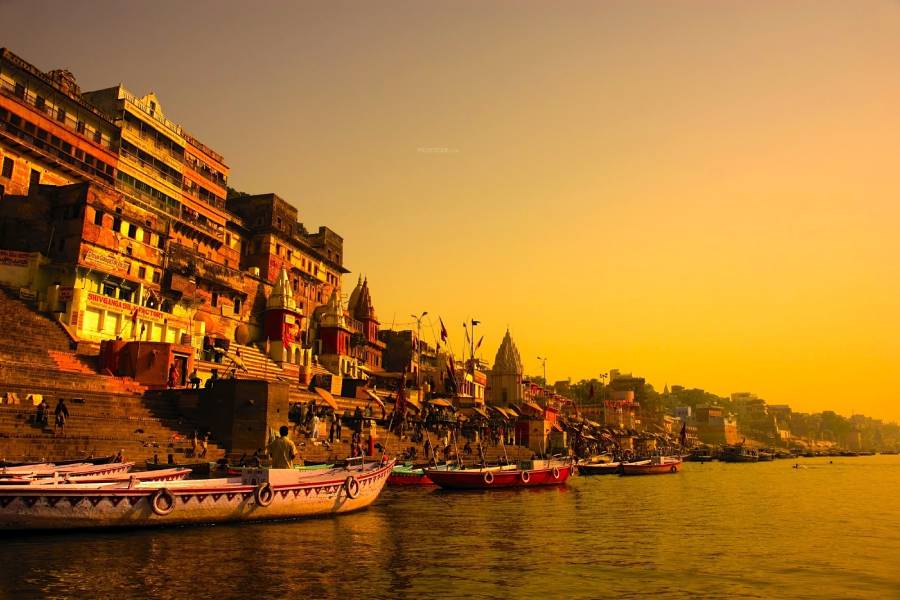6-Day Private Varanasi Ganges Tour Including Delhi, Agra and Jaipur

6-Day Private Varanasi Ganges Tour Including Delhi, Agra and Jaipur
- Skip The Line
- Duration : 6 days (approx.)
- Free cancellation
- Instant confirmation
- Private Tour
Overview
Explore some of India’s most famous sites on a private 6-day tour to Delhi, Agra, Jaipur, and Varanasi. You’ll travel round-trip from Delhi by air-conditioned car and plane. At each destination, a local guide meets you and takes you around the top sights. Highlights include UNESCO World Heritage sites such as the Taj Mahal, along with many temples, mosques, forts, palaces, markets, and sacred Buddhist and Hindu sites in Varanasi. Accommodation, private driver, entrance fees, and guides are included.
- Cover more ground with a private tour
- Insightful commentary provided throughout
- See many of India’s most famous sites in a short time
- Includes 4-star hotel accommodation with breakfast
Itinerary
Humayun’s Tomb
Pickup at 9am from your desired location in Delhi, Gurugram (Gurgaon) or Noida and visit Humayun’s Tomb (Unesco World Heritage site) – is the tomb of the Mughal Emperor Humayun in Delhi sublimely well proportioned, seeming to float above its symmetrical gardens. The arched facade is inlaid with bands of white marble and red sandstone, and the building follows strict rules of Islamic geometry, with an emphasis on the number eight.
Qutub Minar
Qutub Minar (UNESCO World Heritage Site) complex is studded with ruined tombs and monuments, the majestic highlight of which is the Qutab Minar, a 73m-tall 12th-century tower, after which this complex is named.
Lotus Temple
Designed for tranquil worship, Delhi’s beautiful Lotus Temple offers a rare pocket of calm in the hectic city. It is shaped like a lotus flower, with 27 delicate-looking white-marble petals. The temple was created to bring faiths together; visitors are invited to pray or meditate silently according to their own beliefs. Note: Lotus Temple remain closed on every Monday.
India Gate
This imposing 42m-high stone memorial arch was designed by Lutyens in 1921. It pays tribute to around 90,000 Indian army soldiers who died in WWI, the Northwest Frontier operations and the 1919 Anglo-Afghan War.
Parliament House
This circular, colonnaded building, designed by Edwin Lutyens and Herbert Baker, was where the 1947 handover of power from Britain to the newly independent India took place, and parliament still meets here.
Rashtrapati Bhavan
Rashtrapati Bhavan or President House is an official residence of the President of India.Formerly home to the British Viceroy, the President’s House has 340 rooms, with 2.5km of corridors, and it’s fascinating to take a peek inside.
Agra
Late afternoon drive 3hrs to the City of Taj Mahal, Agra. Upon arrival in Agra check inn to the hotel.
Taj Mahal
At sunrise visit Taj Mahal (a Unesco World Heritage Site) – widely considered the most beautiful building in the world. Poet Rabindranath Tagore described it as ‘a teardrop on the cheek of eternity’. Built by Shah Jahan as a memorial for his third wife, Mumtaz Mahal, who died giving birth to their 14th child in 1631. It’s a wealth of white marble and semi-precious stone – « undoubtedly the highlight of the tour »
Agra Fort
In the afternoon visit Agra Fort (a Unesco World Heritage Site) – is a historical fort along the bank of the Yamuna River in the city of Agra. It was the main residence of the emperors of the Mughal Dynasty until 1638 and one of the finest Mughal forts in India.
Jaipur
Later drive 5hrs to the Pink City of Jaipur – Enthralling, historical Jaipur, Rajasthan’s capital. Upon arrival check in to the pre-booked hotel.
Amber Palace
The magnificent, formidable, honey-hued fort of Amber (pronounced ‘amer’), an ethereal example of Rajput architecture, rises from a rocky mountainside about 11km northeast of Jaipur, and is the city’s must-see sight. It comprises an extensive palace complex, built from pale yellow and pink sandstone, and white marble, and is divided into four main sections, each with its own courtyard.
Jal Mahal
Photo Stop at Jal Mahal (Water Palace) – Near the cenotaphs of the maharanis of Jaipur and beautifully situated in the watery expanse of Man Sagar, is this dreamlike palace. It’s origins are uncertain, but it was believed to have been extensively restored if not built by Jai Singh II (1734).
Hawa Mahal – Palace of Wind
Photo Stop at Hawa Mahal (Palace of Winds) – Jaipur’s most distinctive landmark is an extraordinary pink-painted delicately honeycombed hive that rises a dizzying five storeys. It was constructed in 1799 by Maharaja Sawai Pratap Singh to enable ladies of the royal household to watch the life and processions of the city.
City Palace of Jaipur
The City Palace is the residence of the royal family. A complex of courtyards, gardens and buildings. There are palace buildings from different eras, some dating from the early 20th century. It is a striking blend of Rajasthani and Mughal architecture.
Jantar Mantar – Jaipur
Jantar Mantar Observatory (a Unesco World Heritage Site) – is a collection of curving geometric buildings that are carefully calibrated to monitor the movement of the stars and planets.
New Delhi
Later drive 5hrs back to Delhi, upon arrival check inn to the hotel.
Lal Bahadur Shastri International Airport
Take a morning flight to Varanasi from Delhi. Met upon arrival at Varanasi airport and transfer to your pre-booked hotel. Note: Domestic flight is not included
Ganges River
Later in the early evening, You will walk through the old lanes of Varanasi to the Dashawamegh Ghat (Pier) and take a boat ride (Hand Rowed Boat) on the Ganges to view the cremation grounds, You can witness cremations as your boat floats gently past, revealing a ritual that is memorable in its rawness, simplicity, and completeness. Then return to Dashashwamedh Ghat to watch the evening Ganga Aarti ceremony. The Aarti Ceremony is a devotional Hindu ritual performed at dusk on the banks of the Ganges, using fire as an offering to, the affectionately referenced, Maa Ganga, goddess of the holiest river in India.
Ganges River
Your guide will meet you at the hotel before sunrise, so you can witness the amazing spectacle which takes place on Varanasi’s waterfront at the start of every day. A boat ride (Hand Rowed Boat) on the Ganges at dawn, to see the bathing Ghats (river bank) & cremation site. Sunrise on the riverfront, as seen from a boat, can be a spiritually uplifting sight. The life on the Ghats bound in an endless string of rituals, ever-changing aspects of the river & the wide landscape across have fascinated visitors from all over the world. Leave the boat after passing the most important Ghats, back to the hotel for breakfast.
Banaras Hindu University
Established in 1916, BHU is the largest university campus in Asia. Tour the campus and see the Bharat Kala Bhavan museum and the new Vishwanath Temple (Birla Temple), which is an exact replica of the original Vishwanath Temple.
Bharat Mata Temple
Dedicated to the goddess who represents all the goddesses in the India culture. In other words, it can said that Bharat Mata personifies India as a mother goddess. It is a popular shrine of Mother Goddess where a map of undivided India is worshiped.
Monkey Temple (Durga Temple)
Durga temple is also known as the Monkey temple (because of the presence of huge number of monkeys). The temple is dedicated to the Goddess Durga. It was built in the 18th century. The statue of Goddess Durga is not human made, it was appeared by its own in the temple.
Sarnath
After attaining enlightenment at Bodh Gaya the Buddha went to Sarnath, and it was here that he preached his first discourse in the deer park to set in motion the ‘Wheel of the Dharma’. It is one of the most holy sites as in this place the stream of the Buddha’s teaching first flowed. You’ll also visit the Archaeological Museum, which features treasures that date to the 3rd-century BC. Note: Archaeological Museum remains close on every Friday.
